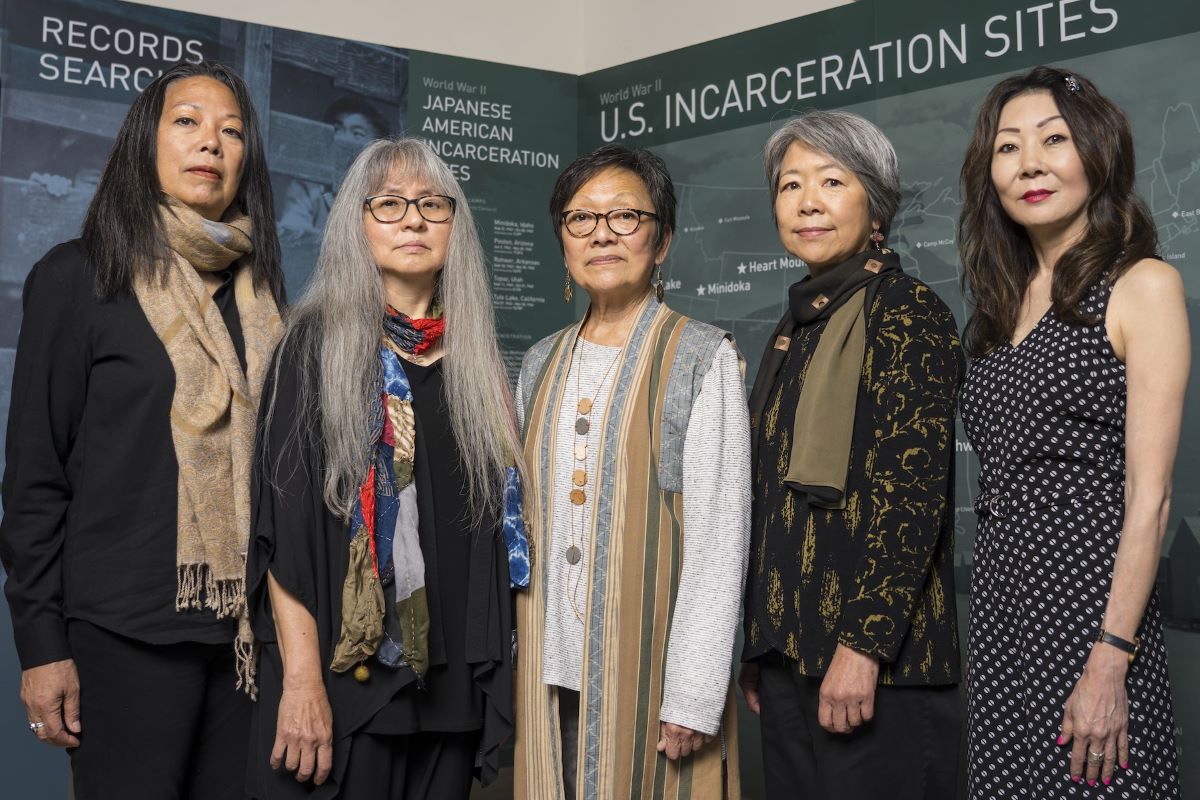Eighty years after the incarceration of more than 126,000 Japanese Americans at internment camps, a group of women artists, known as the Sansei Granddaughters, have come together to pay homage to their ancestors.
The artists point to similarities occuring today, including the incarceration of children and families at the U.S./Mexico border, the Black Lives Matter movement, and the escalation of anti-Asian American hate violence.
The five women have created an art exhibit, “Sansei Granddaughters’ Journey: From Remembrance to Resistance.” The participating artists are Shari Arai DeBoer, Ellen Bepp, Reiko Fujii, Kathy Fujii-Oka, and Na Omi Judy Shintani, all from the San Francisco Bay Area. Their work includes video, installation works, prints, paintings, and mixed media pieces and can be viewed online.
“It is imperative that this atrocity lived by our families is described accurately,” said artist Na Omi Judy Shintani. “Using the correct terminology is crucial to understanding our history. We use the word ‘incarceration’ to emphasize the fact that a majority were U.S. citizens who were punished for looking like the enemy and treated as guilty without due process of law.”
“People who are different are not necessarily dangerous, even if they ‘resemble’ the enemy in some way,” Shintani said. “Learning from the past can lead to the equitable and humane treatment of all people.”
Following the bombing of Pearl Harbor on Dec. 7, 1941, President Theodore Roosevelt signed an executive order in February, 1942, removing all people of Japanese ancestry from their homes. Many never returned to their homes since they were foreclosed due to their inability to pay a mortgage while incarcerated.
There were 10 incarceration camps across the US. During a trip to Manzanar Camp, the five women artists came up with the idea of jointly exhibiting their art. They created a 27-minute documentary film, “Sansei Granddaughters Journey,” which charts the lives of their parents and grandparents who lived at the camp.
“My father was born in America, lived in Japan during this adolescence, but then returned to the U.S. at the age of 18 by himself,” artist Reiko Fujii noted in an interview with EMS. Her father returned to the U.S. without the ability to speak English, and faced a great deal of prejudice as he navigated the customs of his new land. “He felt so much prejudice,” she said.
In 1942, Fujii’s father was first incarcerated at Manzanar Camp in California. He was transferred to Tule Lake Camp in California and, in 1946, ended up at Crystal Ciity Camp in south Texas. Her mother was also incarcerated at Manzanar and Crystal City, but the couple did not meet until 1949 at the home of a friend in Los Angeles.
“I could see how incarceration affected my father. He was very confused about why he was a prisoner. He had less confidence, less self-esteem. All of that was passed down to me,” she said. “But growing up, my parents never told us what camp was.”
As she studied at UC Berkeley Fujii learned about the incarceration camps. In 2021, she released a documentary, “Detained Alien Enemy,” which features — in part — portraits of hundreds of Japanese Americans who were incarcerated.
“My art is not abstract. I want to tell stories from the point of view of the people who were held unjustly imprisoned,” said Fujii. “Not everyone hated being in the camps. Elderly people helped bring up children. Teenagers had boyfriends and girlfriends. There were women who learned to sing and became known for their talent.”
For the exhibit, Fujii created “Detained Alien Enemy Glass Kimono II,” made from thousands of pieces of hand cut glass, fused together to make 240 squares. Each frame displays an image of one or more persons of Japanese ancestry while they were unjustly imprisoned during World War II.
Separately, a permanent installation — The Tanforan Memorial — was unveiled Aug. 27 outside the San Bruno, California BART station. This installation features a replica horse stall in which those incarcerated were housed. It also features a plaza and a bronze statue — based on photographs taken in 1942 by Dorothea Lange — of the Mochida sisters, two young girls dressed in their Sunday best on the way to the Tanforan incarceration center.





